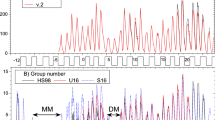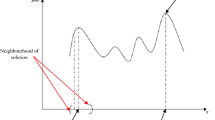Abstract
Model orbits have been fitted to 27 physical double stars listed in a 1922 catalog. A Markov Chain Monte Carlo technique was applied to estimate best-fitting values and associated uncertainties for the orbital parameters. Dynamical masses were calculated using parallaxes from the Hipparcos mission and are presented in this paper with the estimates of the orbital parameters for the 27 systems. The resulting mass estimates of the current study are in good agreement with a recently published study, as are comparisons with the orbital parameters listed by the Washington Double Star catalog, confirming the validity of the optimization methodology.




Similar content being viewed by others
Notes
For further details on STAN see https://github.com/stan-dev/stan and https://mc-stan.org/users/documentation/
References
Al-Wardat M. A., Hussein A. M., Al-Naimiy H. M., Barstow M. A. 2021, PASP, 38, e002. https://doi.org/10.1017/pasa.2020.50
Argyle B. 2004, Observing and Measuring Visual Double Stars (London: Springer-Verlag)
Argyle B., Swan M., James A. 2019, An Anthology of Visual Double Stars, Cambridge University Press
Bevington P. R. 1969, Data Reduction and Analysis for the Physical Sciences (New York: McGraw Hill)
Erdem A., Surgit D., Ozkardes B. et al. 2022, MNRAS, 515, 6151
ESA 1997, ESA Special Publication, 1200
Gaia Collaboration, Prusti T., de Bruijne T. H. J. et al. 2016, A &A, 595, 1
Gaia Collaboration, Vallenari A., Brown A. G. A. et al. 2022, Gaia Data Release 3: Summary of the content and survey properties, arXiv e-prints, arXiv:2208.00211
Hartkopf W. I., Mason B. D., Worley C. E. 2001, AJ, 122, 3472
Hogg D. W., Foreman-Mackey D. 2018, ApJSS, 236, 11
Lucy L. B. 2014, A &A, 563, 126
MacEvoy B., Tirion W. 2015, The Cambridge Double Star Atlas, 2nd edition. Cambridge University Press
Malkov O. Y., Tamaziani V. S., Docobol J. A., Chulkov D. A. 2012, A &A, 546, 69
Masda S., Al-Wardat M. 2023, Advances in Space Research, 72, 649
Mason B. D., Wycoff G. L., Hartkopf W. I. 2022, The Washington Double Star Catalog
Mendez R. A., Claveria R. M., Orchard M. E., Silva J. F. 2017, AJ, 154, 187
Miller J. A., Pitman J. H. 1922, AJ, 34, 127
Perryman M. 2008, Astronomical Applications of Astrometry: Ten Years of Exploitation of the Hipparcos Satellite Data, Cambridge University Press, ISBN 9780521514897, https://doi.org/10.1017/CBO9780511575242
Privault N. 2013, Understanding Markov Chains. Springer Undergraduate Mathematics Series, Springer Singapore, https://doi.org/10.1007/978-981-13-0659-4
R Core Team 2021, R: A language and environment for statistical computing. R Foundation for Statistical Computing, Vienna, Austria
Ribas I., Arenou F., Guinan E. F. 2002, AJ, 123, 2033
Ricker G. R. Winn J. N., Vanderspek R. et al. 2014, Proc. SPIE, Vol. 9143, https://doi.org/10.1117/12.2063489
Sahlmann J., Lazorenko P. F., Ségransan D. et al. 2013, A &A, 556, A133
Sinharay S., 2003, Assessing Convergence of the Markov Chain Monte Carlo Algorithm: A Review, ETS Research Report Series, i-52
Stan Development Team 2021, RStan: the R interface to Stan, http://mc-stan.org/
van Leeuwen F. 2007, A &A, 474, 653
van Ravenzwaaij D., Cassey P., Brown S. D. 2018, Psychon. Bull. Rev., 25, 143. https://doi.org/10.3758/s13423-016-1015-8
Worley C. E., Heintz W. D. 1983, The Fourth Catalog of Orbits of Visual Binary Stars, Publ. US Nav. Obs., 2d Ser., 24, Part 7 (Washington: GPO)
Acknowledgements
This research has used the Washington Double Star (WDS) Catalog maintained at the US Naval Observatory. We thank Dr Rachel Matson for extracting data from the WDS for us. This work has made use of data from the European Space Agency (ESA) mission Gaia (https://www.cosmos.esa.int/gaia), processed by the Gaia Data Processing and Analysis Consortium (DPAC, https://www.cosmos.esa.int/web/gaia/dpac/consortium). Funding for the DPAC has been provided by national institutions, particularly the institutions participating in the Gaia Multilateral Agreement. We thank the University of Queensland for the collaboration software. We thank the anonymous referee for their helpful comments and guidance, which improved this paper.
Author information
Authors and Affiliations
Corresponding author
Rights and permissions
Springer Nature or its licensor (e.g. a society or other partner) holds exclusive rights to this article under a publishing agreement with the author(s) or other rightsholder(s); author self-archiving of the accepted manuscript version of this article is solely governed by the terms of such publishing agreement and applicable law.
About this article
Cite this article
Ersteniuk, M., Banks, T., Budding, E. et al. Markov Chain Monte Carlo optimization applied to double stars from Miller & Pitman research. J Astrophys Astron 45, 9 (2024). https://doi.org/10.1007/s12036-024-09997-5
Received:
Accepted:
Published:
DOI: https://doi.org/10.1007/s12036-024-09997-5




